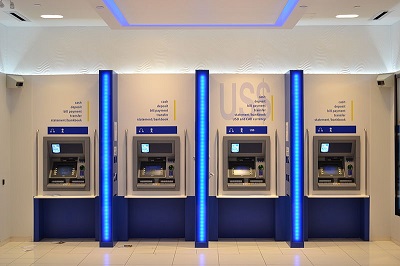According to the research from the UBS investment bank, smartphones could lead to widespread closures.
As a growing number of people start to use mobile banking as a regular part of their interactions with their accounts, it is now being predicted that hundreds of bank branches across Australia may be forced to close.
A survey was conducted by the UBS investment bank and it predicted more than 600 closures.
Analysts from UBS in New York, London, Japan, and Hong Kong partnered up with KPMG in order to produce a massive 54-page report that it has now published and released. Within it, 67 different bank management teams were surveyed across 18 different countries. Among them, there was an average expectation of a branch reduction of 5.6 percent as a direct result of the rise of mobile banking use.
That said, in Australia, that figure is predicted to be about twice the average of closures from mobile banking strategies.
 The report showed that despite the fact that Australia has seen a steady number of bank branches for quite a long time, the survey respondents feel that the country will be facing an 11 percent closure rate as a result of banking over smartphones and other mobile devices.
The report showed that despite the fact that Australia has seen a steady number of bank branches for quite a long time, the survey respondents feel that the country will be facing an 11 percent closure rate as a result of banking over smartphones and other mobile devices.
Based on June 2014 data from the Australian Prudential Regulation Authority, there were 5483 bank branches in the country at that time. Should the predictions of 11 percent be accurate, that would mean that there would be an estimated 603 branch closures across the country.
Because of this fear, many bank branches across the country have worked hard to reconfigure themselves in order to create a much more drop-in style environment and by reducing or removing tellers. This makes it possible for customers to be sold more types of products at their own convenience.
According to the UBS statistics over the span of the next three years, it could easily be that a cumulative reduction of costs by about 10 percent, as well as a boost of 6 percent rise in bank revenues. Over that same span of time, it is anticipated that there will reach the point that 46 percent of mobile related transactions, which Is an increase over the current 25 percent, and the 13 percent from 2013.
Mobile industry is experiencing evolution with the help of companies like Alibaba
China’s mobile industry is beginning to evolve, largely due to Alibaba users that have become very interested in the concept of mobile commerce. Consumers throughout the country are moving away from traditional computers, favoring their mobile devices when it comes to shopping, researching, and purchasing products they are interested in. Alibaba has been known to take advantage of emerging market trends in order to find success and this is why the company has become heavily involved in the mobile commerce space.
Report highlights the growth of mobile commerce in China
A recent report from eMarketer showed that mobile commerce in China is growing, and Alibaba is playing a major role in this growth. The company has invested quite heavily in the mobile space, looking to encourage consumers to use their mobile devices to purchase products online and in physical stores. As such, Alibaba customers have become more heavily involved in mobile commerce. They have also been exposing new people to the concept of mobile commerce by showing them how easy it is to shop online with a smartphone or tablet.
Alipay drives the growth of China’s mobile commerce market
 One of the driving factors of Alibaba’s continued success in the mobile commerce space is its Alipay platform. The platform is the most well known mobile payments service in China, with millions of people using the service to pay for products both online and off. Alipay has also fostered excitement among consumers regarding new retail trends. More retailers are beginning to focus on the mobile space, which means that they are showing more support for mobile payments being made through services like Alipay.
One of the driving factors of Alibaba’s continued success in the mobile commerce space is its Alipay platform. The platform is the most well known mobile payments service in China, with millions of people using the service to pay for products both online and off. Alipay has also fostered excitement among consumers regarding new retail trends. More retailers are beginning to focus on the mobile space, which means that they are showing more support for mobile payments being made through services like Alipay.
Companies are growing more mobile-centric
As consumers become more interested in mobile commerce, China’s mobile industry is expected to experience a significant shift. More companies are expected to become more mobile-centric in order to meet the needs of consumers. This trend is already being seen in the retail industry, where several companies have embraced mobile commerce as a way to effectively engage a new generation of consumers with smartphones.
 The report showed that despite the fact that Australia has seen a steady number of bank branches for quite a long time, the survey respondents feel that the country will be facing an 11 percent closure rate as a result of banking over smartphones and other mobile devices.
The report showed that despite the fact that Australia has seen a steady number of bank branches for quite a long time, the survey respondents feel that the country will be facing an 11 percent closure rate as a result of banking over smartphones and other mobile devices.
 One of the driving factors of Alibaba’s continued success in the mobile commerce space is its Alipay platform. The platform is the most well known mobile payments service in China, with millions of people using the service to pay for products both online and off. Alipay has also fostered excitement among consumers regarding new retail trends. More retailers are beginning to focus on the mobile space, which means that they are showing more support for mobile payments being made through services like Alipay.
One of the driving factors of Alibaba’s continued success in the mobile commerce space is its Alipay platform. The platform is the most well known mobile payments service in China, with millions of people using the service to pay for products both online and off. Alipay has also fostered excitement among consumers regarding new retail trends. More retailers are beginning to focus on the mobile space, which means that they are showing more support for mobile payments being made through services like Alipay.